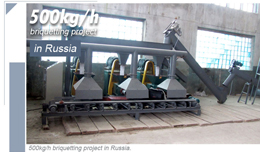Feasibility Analysis on Straw Briquetting Equipment
In accordance with the guiding spirit of the state, which vigorously advocates and supports the development and utilization of biomass energy, actively develops modern agriculture and promotes the construction of a new socialist countryside, the investors who invest in straw fuel production have no need to apply for business license and pay tax and administrative fees, also the local government would freely offer the production location for the producers, reducing the discharging, and providing finance support, economic subsidy and other relative preferential policies, thus reducing the investment burden and making the inventors higher economic benefits.
The cost and profit accounting of straw fuel briquetting, calculated by 10 ton per day.
- Straw material purchasing price (at a highest estimate): ¥100/t
- Crushing cost (corn stalk), crushing power: 5.5kw*¥0.8/d=¥4.4/t
- Briquetting cost and power: 22kw*¥0.8/d=¥17.6/t
- Needing 5 labors: 5*¥40=¥200; ¥200/10t=¥20/t
- Total cost: ¥100+¥4.4+¥17.6+¥20=¥142/t (cost)
- Profit: the lower market price: ¥350-¥142=¥208
- 10t/d*208t=¥2080/d per day profit
Our factory not only produce and sell the complete straw briquetting equipment, but also offer biomass pelletizing equipment.
Straw Biomass Energy Market in Chine
For the past few years, the state vigorously advocates and supports the development and utilization of biomass energy, and has invested and built more than 110 biomass power plants throughout the country. However, the output of straw fuel far from meet the market demand. The market price range from ¥450 to ¥550 per ton, causing situation of demand exceeds supply.It is predicted by the international renewable energy organization that, according to current utilization ratio exploitation, the reserves of oil, natural gas and coal underground can be used for about 60 years only. Therefore, the biomass energy like straw is an important developing direction for future renewable energy. With the development of worldwide energy shortage, the market demand and profit space for biomass renewable energy would be immeasurable.
Straw Processing Equipment
For biomass power plants with straw fuel, there are currently two kinds of processing equipment, straw briquetting euipment, straw pellet machine.
Straw fuel Technical Parameter:
The volume of final straw briquette fuel occupies 1/90~40 of raw straw only, is 10~20 times more of the same weight of straws. The final straw briquette is with the density of 0.8~1.2g/cm3, the heat value of 3400~6000 Kcal, the sulphur content of below 0.005, which is the solid fuel with high volatile phenols, with combustion ratio in over 95%, and the left ash is the high quality potash fertilizer used to returned to the fields to improve soil.Taking corn straw fuel particles as an example: when using the corn straw briquette fuel in the mating biomass fuel stove, its combustion ratio is 1.3-1.5 times of stove burning coal fuel. Thus, the heating value utilization of one ton straw briquette fuel is the same with that of one ton coal.
If putting the straw briquettes into the 0.8 ton vertical boiler for combustion, the exhaust gas will be discharged from the chimney after passing through a spray-type dust collector. After testing, when the density of straw fuel is in 1.0~1.27g/cm3, the combusting room temperature can be 1060° at the end of combustion, with the combustion rate more 15% than coal combustion. In the normal combustion, there is no smoke and soot poured out from chimney. Adding 5 kg of straw fuel briquette fuel form one time, after closing the air door, it can burn for 4 hours. The emission concentration of Co, Co2,So2, NoX and other components in flue gas is 138mg/cm3, and the emission concentration of So2 is only 75mg/cm3, which is much lower than the index of the "Boiler Atmospheric Pollutant Emission Standard" (GWPB3-1999), meeting the national environmental protection requirements.
Value Analysis List and Comparison of Biomass Straw Fuel
| Fuel Type | Industrial analysis ingredient | Elements composition (﹪) | Lower calorific value (Kj/Kg) | ||||||||
|---|---|---|---|---|---|---|---|---|---|---|---|
| Moisture content | Ash | Volatile Penol | Solid carbon | H | C | S | N | P | Ko2 | ||
| Corn straw | 6.10 | 4.70 | 76.00 | 13.20 | 6.00 | 49.30 | 0.11 | 0.70 | 2.60 | 13.80 | 17746 |
| Corn cob | 4.87 | 5.93 | 71.95 | 17.25 | 6.00 | 47.20 | 0.01 | 0.48 | — | — | 17730 |
| Wheat straw | 4.39 | 8.90 | 67.36 | 19.32 | 6.20 | 49.60 | 0.07 | 0.61 | 0.33 | 20.40 | 18532 |
| Rice straw | 3.61 | 12.20 | 67.80 | 16.39 | 5.30 | 48.30 | 0.09 | 0.81 | 0.15 | 9.93 | 17636 |
| Rice husk | 5.62 | 17.82 | 62.61 | 13.95 | 6.20 | 49.40 | 0.40 | 0.30 | — | 0.60-1.60 | 16017 |
| Grass | 5.43 | 9.4 | 68.72 | 16.40 | 5.24 | 41.00 | 0.22 | 1.59 | 1.68 | 13.60 | 16204 |
| beanpoles | 5.10 | 3.13 | 74.56 | 17.12 | 5.81 | 44.79 | 0.11 | 5.85 | 2.86 | 16.33 | 16157 |
| Peanut shell | 7.88 | 1.60 | 68.10 | 22.42 | 6.70 | 54.90 | 0.10 | 1.37 | — | — | 21417 |
| Sorghum straw | 4.71 | 8.91 | 68.90 | 17.48 | 6.09 | 48.63 | 0.01 | 0.36 | 1.12 | 13.60 | 15066 |
| cotton stalk | 6.78 | 3.97 | 68.54 | 20.71 | 5.70 | 49.80 | 0.22 | 0.69 | -2.10 | 24.70 | 18089 |





